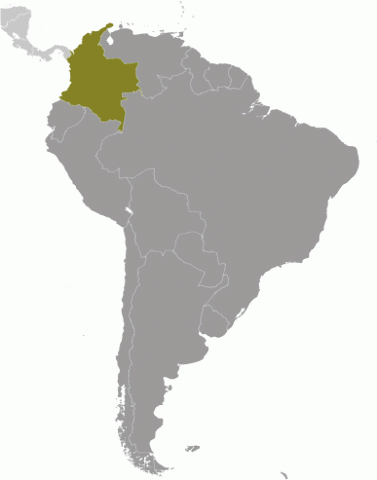Child Labor and Forced Labor Reports
Colombia


Significant Advancement
In 2024, Colombia made significant advancement in efforts to eliminate the worst forms of child labor. The government hosted the first Global Ministerial Conference on Ending Violence Against Children, spearheading the efforts of 119 countries to combat and prevent commercial sexual exploitation, trafficking in persons for further labor exploitation and servitude, and recruitment of children for use in armed conflict, among other forms of violence. In addition, the government coordinated actions with partners from Peru and Brazil to eradicate child labor and commercial sexual exploitation of children and adolescents along their shared borders. The Ministry of Labor delivered significant training programs and technical assistance that focused on eradicating child labor to the capital area of Bogota, 29 of the country’s 32 departments (territorial entities), and over 50 percent of all municipalities in the country. Moreover, the government’s Open Your Eyes anti-trafficking awareness program reached more than 100,000 children and adolescents. However, despite these efforts, the number of labor inspectors is insufficient to fully cover a workforce of over 25.2 million workers. In addition, social programs in Colombia are not adequate to address the full scope of the country’s child labor problem, particularly in areas impacted by armed conflict. Finally, children continue to be at risk for recruitment and use by criminal or armed groups, including for illicit activities and commercial sexual exploitation, human trafficking, and forced labor.
| Children | Age | Percent and Population |
|---|---|---|
| Working | 5 to 14 | 0.9% (72,428) |
| Boys | 1.2% | |
| Girls | 0.5% | |
| Urban | 0.4% | |
| Rural | 2.4% | |
| Hazardous Work by Children | 15 to 17 | 2.1% (51,469) |
| Boys | 3.1% | |
| Girls | 0.8% | |
| Urban | 1.5% | |
| Rural | 3.5% | |
| Attending School | 5 to 14 | 94.3% |
| Combining Work and School | 7 to 14 | 0.8% |
| Sector/Industry | Percent of Population |
|---|---|
| Agriculture | 52.5% |
| Industry | 17.0% |
| Services | 30.5% |
| Sector/Industry | Activity |
|---|---|
| Agriculture | Working in animal husbandry,† forestry, hunting, fishing,† and agriculture,† including in the production of coca (stimulant plant), coffee, sugarcane,† pome and stone fruits, and grapes. |
| Industry | Mining† coal, emeralds, and gold. Construction,† particularly in large-scale projects. Producing bricks. |
| Services | Street work,† including vending and helping shoppers carry bags in urban markets,† begging,† and guarding cars and motorcycles.† Domestic work,† including caring for children,† cooking, gardening, and shopping for the home. Working in retail establishments, hotels, and restaurants. Recycling.† |
| Categorical Worst Forms of Child Labor‡ | Commercial sexual exploitation, sometimes as a result of human trafficking. Use in the production of pornography. Forced street vending and forced begging. Use in illicit activities by illegal armed groups and criminal organizations, including committing homicides and extortions, trafficking drugs, and the production of coca, each sometimes as a result of human trafficking. Recruitment and use of children by non-state armed groups for armed conflict and forced labor. |
† Determined by national law or regulation as hazardous and, as such, relevant to Article 3(d) of ILO C. 182.
‡ Child labor understood as the worst forms of child labor per se under Article 3(a)–(c) of ILO C. 182.
Children at Higher Risk
In Colombia, children from rural farming areas are economically disadvantaged and thus are more vulnerable to the worst forms of child labor. Children from Venezuela and Ecuador residing in Colombia are at risk for commercial sexual exploitation and street work. These children, as well as those who have become separated from their families while transiting through areas of the country where state institutions have limited capacity, are at greater risk of being recruited and used by criminal organizations and armed groups for labor and commercial sexual exploitation, in many cases as a result of human trafficking. Children in the departments of Arauca, Cauca, Chocó, Córdoba, Nariño, Norte de Santander, Putumayo, and Valle del Cauca are at higher risk of child soldier recruitment or use by non-state groups for armed conflict, as well as recruitment by criminal organizations. Girls are also at risk of being put to domestic and care work early and subjected to exploitative labor practices. In addition, girls living in areas with international tourism, in mining communities, and in areas with large construction projects are vulnerable to commercial sexual exploitation, human trafficking, and forced labor. Child recruitment by non-state armed groups for use in armed conflict increased significantly; Colombian official sources stated a range from 541 to 650 children recruited in 2024 up from 184 in 2023. Reports indicate that the government may not be sufficiently addressing the problem, including insufficient early interventions to mitigate recruitment, screening of vulnerable youth, monitoring and case number underreporting, and a lack of reintegration support for rescued children.
Barriers to Education Access
Children in under-resourced areas of the country face barriers to accessing education due to poor school infrastructure, violence at school, and long distances to schools combined with a lack of adequate transportation. Homeless children and children under state protection may also face challenges, institutional resistance, and/or lack of proper capacity at educational institutions. Children who are older than the regular enrollment age, or children trying to reintegrate into the school process late in the school year, as well as children who experience difficulties proving their level of education, may experience barriers in the process of enrollment.
| Standard | Age | Meets International Standards | Legislation |
|---|---|---|---|
| Minimum Age for Work | 17 | ✓ | Article 35 of the Child and Adolescence Code |
| Minimum Age for Hazardous Work | 18 | ✓ | Article 117 of the Child and Adolescence Code |
| Identification of Hazardous Occupations or Activities Prohibited for Children | ✓ | Article 3 of Resolution 1796 | |
| Prohibition of Slavery, Debt Bondage, and Forced Labor | ✓ | Article 17 of the Constitution; Article 188A of the Penal Code | |
| Prohibition of Child Trafficking | ✓ | Article 17 of the Constitution; Articles 188A–188C and 231 of the Penal Code; Law No. 2168 | |
| Prohibition of Commercial Sexual Exploitation of Children | ✓ | Articles 213–219B of the Penal Code | |
| Prohibition of Using Children in Illicit Activities | ✓ | Articles 162, 188D, and 384 of the Penal Code | |
| Minimum Age for Voluntary State Military Recruitment | N/A | ||
| Prohibition of Compulsory Recruitment of Children by (State) Military | ✓ | Article 4 of Law 1861 | |
| Prohibition of Military Recruitment by Non-state Armed Groups | ✓ | Article 162 of the Penal Code; Article 20 of the Child and Adolescence Code; Article 14 of Law 418 | |
| Compulsory Education Age | 18 | ✓ | Decree 4807 of 2011 |
| Free Public Education | ✓ | Articles 2.3.1.6.4.1 and 2.3.1.6.4.2 of Decree 1075; Article 1 of Decree 4807; Article 28 of the Child and Adolescence Code |
As the minimum age for work is lower than the compulsory education age, children may be encouraged to leave school before the completion of compulsory education.
| Organization/Agency | Role & Activities |
|---|
| Ministry of Labor (MOL): Receives complaints of labor law violations and conducts labor inspections, including inspections to verify labor conditions for adolescent workers and compliance with other child labor provisions through its Inspection, Monitoring, Control, and Territorial Management Directorate. Also, oversees the Internal Working Group on Child Labor Eradication. Additionally, the Unit for Labor Protections at the Directorate of Fundamental Rights operates the Comprehensive Child Labor Information System (SIRITI), a monitoring system that identifies children engaged in or at risk of child labor. In 2024, the ministry began using the mobile SIRITI app on Android devices for the first time, allowing staff to rapidly process data and upload it into a database. |
| Attorney General’s Office (AGO): Investigates and prosecutes cases of child recruitment for use in armed conflict and illicit activities, commercial sexual exploitation, forced labor, and human trafficking. With support from the Office’s Technical Investigation Unit, advises the Attorney General on the design of policies and strategies related to the role of judicial police investigators. Oversees the Coordination Group for Addressing Trafficking in Persons, which includes prosecutors, analysts, and judicial police engaged in addressing organized crime and human trafficking. |
| Overview of Enforcement Efforts | 2024 |
|---|---|
| Has a Labor Inspectorate | Yes |
| Able to Assess Civil Penalties | Yes |
| Routinely Conducted Worksite Inspections | Yes |
| Unannounced Inspections Permitted | Yes |
| Has a Complaint Mechanism | Yes |
| Imposed Penalties for Child Labor Violations | Yes |
| Conducted Criminal Investigations for Worst Forms of Child Labor Crimes | Yes |
| Imposed Penalties for Worst Forms of Child Labor Crimes | Yes |
In 2024, 1,156 labor inspectors conducted an unknown number of worksite inspections, including 562 site visits to inspect working conditions of authorized to work adolescents, and found 0 child labor violations. The government also conducted 2,086 investigations into suspected cases of the worst forms of child labor, initiated 456 prosecutions, and convicted 123 perpetrators.
| Coordinating Body | Role & Activities |
|---|
| Interagency Committee for the Elimination of the Worst Forms of Child Labor and Protection of the Adolescent Worker (CIETI): Coordinates efforts to address the worst forms of child labor. Chaired by MOL, it includes 21 Colombian government agencies and at least three representatives from non-governmental entities: one from trade unions, one from economic sectors influencing the municipality, and one representative from civil society or an organization that safeguards the rights of children and adolescents. Oversees department-level CIETIs throughout the country, each comprising municipal-level committees. In 2024, the national committee convened three times, and the number of municipal-level CIETIs increased from 703 to 809. |
| Policy | Description & Activities |
|---|
| National Policy Guidelines to Prevent and Eradicate Child Labor and Protect the Adolescent Worker (2017–2027): Aims to address child labor in the agriculture sector, develops child labor prevention strategies, improves the quality and coverage of child protection services, protects adolescent workers from hazardous work, creates strategies to address child labor in domestic work, and establishes evaluation and monitoring mechanisms to assess progress. Contains a roadmap to prevent and eliminate child labor in mining and a cooperative agreement between the Ministry of Mining and Energy and the Colombian Institute of Family Welfare (Instituto Colombiano de Bienestar Familiar [ICBF]) to prevent child labor in mining. In 2024, MOL implemented the National Policy through technical assistance to national and local territorial entities, including 29 Departments, the capital, and 631 municipalities. |
| National Strategy for the Prevention and Eradication of the Commercial Sexual Exploitation of Children (2018–2028): Guides government actions at the national, departmental, and municipal levels for the prevention of commercial sexual exploitation, survivor assistance, and the strengthening of sentencing for perpetrators. As a core part of this strategy, the government maintains an "Eyes in All Places" (Ojos en Todas Partes) public awareness campaign, which aims to prevent child sexual exploitation and abuse in tourism. The campaign is led by MOL through the National Consulting Interagency Committee. The Committee consists of the Ministry of Commerce, Industry, and Tourism; ICBF; the AGO; the National Police; UNICEF; the Foundation Renacer; and regional and municipal authorities. In 2024, the MOL partnered with UNODC to combine efforts in delivering awareness-raising, prevention, and eradication efforts in the regions of the country most affected by the commercial sexual exploitation of children and adolescents. Research could not determine whether activities took place during the reporting period. |
| National Policy for the Prevention of Recruitment, Use, and Sexual Violence Against Children and Adolescents by Illegal Armed Groups of Organized Criminal Groups (2018–2028): Directs government actions to prevent the recruitment and use of children by armed groups, address violence against children, and improve interagency coordination. The government also has a roadmap that establishes protocols to assist child survivors of armed conflict. Research could not determine whether activities took place during the reporting period. |
† The government has other policies that may have addressed child labor issues or had an impact on child labor.
| Program | Description & Activities |
|---|
| Campaigns Against Child Labor:‡ While leading the Family National Welfare System, ICBF conducts campaigns to increase coordination with other agencies at the national, departmental, and municipal levels for the protection of children and adolescents. In 2024, ICBF continued providing services to children and adolescents in situations of child labor and street life through Mobile Teams for Comprehensive Protection (EMPI). During the reporting period, 51 EMPIs were active, and 153 members of the teams assisted across 33 Regional Directorates. |
| Programs Addressing Trafficking in Persons:‡ Aim to raise awareness of child trafficking crimes. The AGO oversees the “Don’t be Fooled" (#EsoEsCuento) public awareness campaign to prevent human trafficking. In 2024, the campaign launched a webpage (www.esoescuento.com) that serves as a knowledge portal and a hotline to report suspected trafficking in persons cases. The Ministry of the Interior conducts a public awareness campaign to educate the public on human trafficking and available resources, including a national anti-trafficking hotline. The National Police also implement their own public awareness and child protection program, called “Open Your Eyes” (Abre Tus Ojos). The program aims to protect children from exploitation in the worst forms of child labor. The "Open Your Eyes" program included 855 capacity-building sessions and 166 sports and recreational events benefiting 103,736 children and adolescents during the reporting period. |
| Programs Addressing Poverty and Youth Development:‡ Citizen Income (Renta Ciudadana) replaced the Families in Action program (Familias en Acción) in 2024. The program uses a conditional cash transfer program to address extreme poverty. United Network (Red Unidos) coordinates actions to end extreme poverty; Healthy Generations (Generaciones con Bienestar) operates a children’s rights program that offers activities for children ages 6 to 17 identified as vulnerable to the worst forms of child labor; and Youth in Action (Jóvenes en Acción) provides technical job training and conditional cash transfers to vulnerable urban youth ages 16 to 24. In 2024 this program was renamed Youth Income (Renta Joven). |
‡ Program is funded by the Government of Colombia.
† The government had other social programs that may have included the goal of eliminating or preventing child labor.
| Area | Suggested Action |
|---|---|
| Legal Framework | Raise the minimum age for work from age 17 to age 18 to align with the compulsory education age. |
| Enforcement | Improve information collection and reporting on the number of children recruited by non-state armed groups. |
| Increase screening and mitigation efforts to prevent non-state armed groups from recruiting children; reinforce local authorities' capacity building and reintegration services for children rescued from non-state armed groups. | |
| Increase the number of labor inspectors from 1,156 to 1,681 to ensure adequate coverage of the labor force of approximately 25.2 million workers. | |
| Publish information on the number of children removed from child labor due to inspections and the number of children referred to social services. Also regularly update and publish information on penalties imposed and collected for child labor violations. | |
| Ensure that labor inspectors do not encounter any barriers to conducting inspections in private residences in which child labor is suspected. | |
| Adopt a case management system connecting the Attorney General’s Office and the Superior Council of the Judiciary to effectively track criminal proceedings from investigation to sentencing, including penalties handed down after conviction. | |
| Ensure that all children rescued from child labor situations are referred to social services. | |
| Government Policies | Ensure that activities to implement the National Strategy for the Prevention and Eradication of the Commercial Sexual Exploitation of Children (2018–2028) are undertaken and make this information publicly available. |
| Social Programs | Improve access to education for all children, including by ensuring adequate transportation to school, improving school infrastructure, and addressing violence affecting school attendance. |
| Expand social programs to sufficiently address the scope of the worst forms of child labor, particularly commercial sexual exploitation, forced begging, and recruitment for use in illicit activities. |













